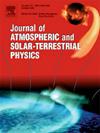The importance of electric field or/and neutral wind in formation and prediction of sporadic E (Es) at the equatorial and mid-latitude regions
IF 1.9
4区 地球科学
Q3 GEOCHEMISTRY & GEOPHYSICS
Journal of Atmospheric and Solar-Terrestrial Physics
Pub Date : 2025-05-13
DOI:10.1016/j.jastp.2025.106540
引用次数: 0
Abstract
This study investigates the formation and localization of sporadic E(Es) at equatorial and mid-latitude regions in case of presence of electric field or/and neutral wind. It has been shown that at the equatorial region, in analogy to the mid-latitude regions, the necessary condition for development of ion vertical convergence and formation of sporadic E (Es) is the presence of the minimal negative value of ion drift velocity divergence in its height profile (including only a vertical component). This condition at the equatorial region is significantly determined by the neutral wind velocity and the zonal and vertical components of the electric field, even when this field is homogeneous. The ions vertical convergence developed in these regions and the formation of the Es layer can take place against the background of their upward or downward drift. Sporadic layer localizes either at the node of the ions drift velocity, or in the regions where this velocity disappears. The formation and dynamics of Es layers are demonstrated by numerical methods which makes possible its prediction. The effects of the zonal and vertical components of the electric field, as well as the wind velocity (determined by the HWM14 data), on the processes of ion convergence/divergence development, at equatorial and mid-latitudes, are shown. In these cases, the ion convergence/divergence, induced by the electric field, can affect both the formation and disruption (depletion) of the Es layer formed by neutral wind, and can also increase its density or/and form an additional layer. It is also shown that the presence of electric field, along with the meridional and zonal wind at mid-latitudes, can affect both the formation and the behavior of Es layers at these regions.
电场或/和中性风在赤道和中纬度地区零星E (Es)形成和预报中的重要性
本文研究了在电场或中性风存在的情况下,赤道和中纬度地区零星E(Es)的形成和定位。研究表明,在赤道地区,与中纬度地区类似,离子垂直辐合发展和零星E (Es)形成的必要条件是离子漂移速度散度在其高度剖面中存在最小的负值(仅包括垂直分量)。赤道地区的这种情况在很大程度上取决于中性风速和电场的纬向分量和垂直分量,即使电场是均匀的。离子垂直辐合在这些区域发展,并在离子向上或向下漂移的背景下形成Es层。偶散层既存在于离子漂移速度的节点,也存在于离子漂移速度消失的区域。用数值方法证明了Es层的形成和动力学,使其预测成为可能。显示了纬向和垂直场分量以及风速(由HWM14数据确定)对赤道和中纬度离子辐合/辐散发展过程的影响。在这些情况下,由电场引起的离子辐合/发散可以影响中性风形成的Es层的形成和破坏(耗尽),并且还可以增加其密度或/并形成附加层。研究还表明,电场的存在以及中纬度地区经向风和纬向风的存在对这些地区Es层的形成和行为都有影响。
本文章由计算机程序翻译,如有差异,请以英文原文为准。
求助全文
约1分钟内获得全文
求助全文
来源期刊

Journal of Atmospheric and Solar-Terrestrial Physics
地学-地球化学与地球物理
CiteScore
4.10
自引率
5.30%
发文量
95
审稿时长
6 months
期刊介绍:
The Journal of Atmospheric and Solar-Terrestrial Physics (JASTP) is an international journal concerned with the inter-disciplinary science of the Earth''s atmospheric and space environment, especially the highly varied and highly variable physical phenomena that occur in this natural laboratory and the processes that couple them.
The journal covers the physical processes operating in the troposphere, stratosphere, mesosphere, thermosphere, ionosphere, magnetosphere, the Sun, interplanetary medium, and heliosphere. Phenomena occurring in other "spheres", solar influences on climate, and supporting laboratory measurements are also considered. The journal deals especially with the coupling between the different regions.
Solar flares, coronal mass ejections, and other energetic events on the Sun create interesting and important perturbations in the near-Earth space environment. The physics of such "space weather" is central to the Journal of Atmospheric and Solar-Terrestrial Physics and the journal welcomes papers that lead in the direction of a predictive understanding of the coupled system. Regarding the upper atmosphere, the subjects of aeronomy, geomagnetism and geoelectricity, auroral phenomena, radio wave propagation, and plasma instabilities, are examples within the broad field of solar-terrestrial physics which emphasise the energy exchange between the solar wind, the magnetospheric and ionospheric plasmas, and the neutral gas. In the lower atmosphere, topics covered range from mesoscale to global scale dynamics, to atmospheric electricity, lightning and its effects, and to anthropogenic changes.
 求助内容:
求助内容: 应助结果提醒方式:
应助结果提醒方式:


